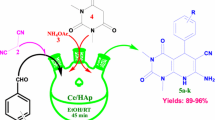Abstract
Novel heterogeneous catalysts, which were designed with atomic precision, easy to prepare, and recyclable, have been developed using a unique inorganic support hydroxyapatite, Ca10(PO4)6(OH)2. The introduction of a Ru cation into the apatite framework can generate a stable monomeric phosphate complex, which exhibits prominent catalytic performances for various oxidation reactions using molecular oxygen as a primary oxidant. Treatment of the RuHAP with an aqueous solution of AgX affords cationic Ru phosphate complexes as Lewis acid catalysts, promoting Diels–Alder and aldol reactions under mild and neutral conditions. Furthermore, two classes of heterogeneous Pd catalysts were synthesized with both stoichiometric and Ca-deficient hydroxyapatites, which show specific functions for aerobic oxidation of alcohols and carbon–carbon bond-forming reactions with extremely high turnover numbers. The catalytic systems described here are simple, efficient, and general for practical organic syntheses; thus meeting the increasing demands for environmentally-benign chemical processes.
Similar content being viewed by others
Author information
Authors and Affiliations
Corresponding author
Rights and permissions
About this article
Cite this article
Kaneda, K., Mori, K., Hara, T. et al. Design of hydroxyapatite-bound transition metal catalysts for environmentally-benign organic syntheses. Catal Surv Asia 8, 231–239 (2004). https://doi.org/10.1007/s10563-004-9114-3
Issue Date:
DOI: https://doi.org/10.1007/s10563-004-9114-3




